 |
 |
|
Our Projects include: |
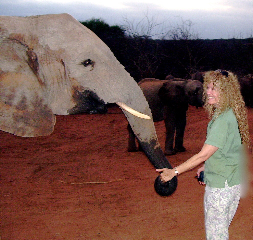 |
Working for Elephant Conservation in Africa
When I see an elephant family, free and happy in the wild, the little babies playfully cavorting in the mud with the female adults so tenderly and protectively looking after them, and see a majestic bull elephant in the power of his musth with so much triumphant dignity, every part of my being rises up with one purpose: to do all I possibly can to conserve them in all their magnificence. So, since 2003, I have been working in the US, Asia, South Africa and Kenya to protect and preserve elephants.
In the UK, I had the great joy of meeting Will Travers, the director
of Born Free. What an incredible and generous man he is and his
organization is doing fantastic work around the world for wildlife:
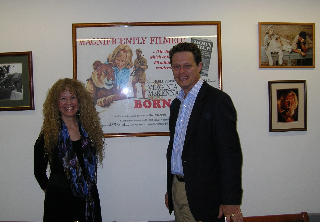
Will Travers of www.bornfree.org.uk/
In Kenya, I was privileged to meet some of the world's top elephant experts and my heros...

Dr. Iain Douglas-Hamilton, www.savetheelephants.com

Dr. Daphne Sheldrick, www.sheldrickwildlifetrust.org

Cynthia Moss, www.elephanttrust.org
I also met some Maasai and Samburu warriors and elders. I had not expected
to be so blessed. I am writing a book about the conversations I had with
them.
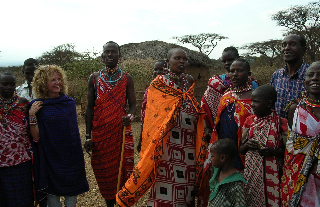
In Africa, some tribes people greet each other thus..
"How are you?"
"I am well if you are well."
"I am well."
"Good, then we are both well."
I would add that I am well if the elephants are well, but they are not.
This is what I discovered in Africa...
The threats to elephants in the wild are the following:
1. Poaching and The Ivory Trade
2. Legal slaughter (euphemistically called culling)
3. Loss of habitat (due to over population of humans)
4. Drought and global warming
5. Domestication
I will take these one by one:
POACHING AND THE IVORY TRADE
Prior to the ban on ivory trade which took place in December of 1989,
thanks to the hard work of Drs. Iain Douglas-Hamilton and Richard Leakey,
the elephant population had plummeted from about 3 million, Africa wide,
to only 240,000. Kenya alone lost 85% of its elephant population and now
only has about 27,000.
But poaching is, once again on the rise. Now one can go to Khartoum, the
capital of Sudan and there find (according to Dr. Esmond Bradley-Martin),
in open display, 12,000 pieces of ivory being sold in 50 shops. That represents
the death of thousands of elephants.
75% of the poached ivory is being bought by China and is supplied mostly
by the Congo, Chad and some from Kenya.
In elephant society, knowledge and wisdom of where to find water during
a drought, where food and safe places are and how to dig for water, are
passed down from the oldest and wisest matriarch. When they are poached
for their ivory, that knowledge is lost and the herd then becomes weak,
vulnerable, and confused. Of course, if the matriarch had any babies,
they will die without her milk. So when one elder ele is killed for her
ivory, it represents the death of many more.
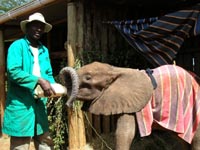
(Orphaned ele rescued by the team at Daphne Sheldrick's orphanage.)
People poach elephants mostly for greed. But famine and war contribute
to it also. If people are hungry, they will kill an elephant for food.
If tribes are at war, they will kill an elephant for its ivory to pay
for weapons.
Preserving elephants requires stable economies, prosperity and peace among
tribes and nations. These issues must also be addressed and solved if
elephants are to survive.
LEGAL SLAUGHTER (EUPHEMISTICALLY CALLED "CULLING")
The southern African countries (South Africa, Zimbabwe, Namibia) claim
they have too many elephants and so they solve the problem by killing
them.
When they kill elephants, they have to kill the whole family. They have
discovered over the years, that if they don't kill all the members of
an elephant family, those left are terribly traumatized and because eles
can communicate over long distances through the use of infra sound, other
herds find out about the massacre. And elephants never forget.
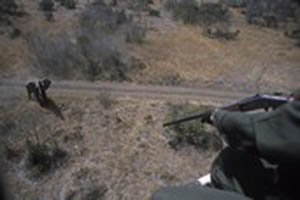 An elephant conservationist
from Kenya was taken up in a small plane to fly over the elephants in
Kruger Park of South Africa where they slaughter their elephants. Much
to his surprise the eles fled in a panic at the sound and sight of the
plane. He had never seen this happen in Kenya. He asked his South African
host about this who thought it was normal! The eles remember culling and
where responding to the plane with fear.
An elephant conservationist
from Kenya was taken up in a small plane to fly over the elephants in
Kruger Park of South Africa where they slaughter their elephants. Much
to his surprise the eles fled in a panic at the sound and sight of the
plane. He had never seen this happen in Kenya. He asked his South African
host about this who thought it was normal! The eles remember culling and
where responding to the plane with fear.
There is the story of a slaughter taking place. A mother elephant was
shot but not quite dead. The man doing the evil deed was lifting his rifle
up to shoot her daughter. The dying elephant lifted her trunk and put
it on the man's arm to pull it away from the rifle. To keep him from killing
her baby. They feel just like we do. They love just like we do. They fear
death just like we do.
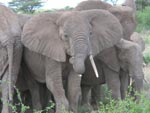 When a whole family
is killed it's genetic variability is lost forever.
When a whole family
is killed it's genetic variability is lost forever.
Fact is, there are other ways for dealing with this problem. One is to
open up corridors into other countries where the elephants can roam. This
is being done. Another is through the use of contraception. I worked with
a conservationist by the name of Audrey Delsink, who has successfully
stopped the overpopulation of elephants in a private reserve called Makalali
in South Africa through the use of a simple vaccine that is a contraception.
But South African officials and many South Africans do not want to use
it. They ask: "What's in it for us?". The legal slaughter of the elephants
in S. Africa provides food, skin and ivory. And that is what they really
want.
LOSS OF HABITAT DUE TO HUMAN OVERPOPULATION
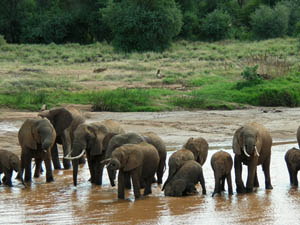 This should not need to be mentioned. It is pandemic. Yet humans continue
to multiply with no awareness of the devastation such huge numbers is
causing the environment, the earth, all wildlife, and especially elephants.
This should not need to be mentioned. It is pandemic. Yet humans continue
to multiply with no awareness of the devastation such huge numbers is
causing the environment, the earth, all wildlife, and especially elephants.
Elephants require huge space to roam. A bull elephant can easily travel
over 50 miles in a day. And they do so in search of food, water or just
to visit some old friends. It is said (National Geographic show: Elephant)
that the population in Africa increases by 55,000/day! The human need
for housing and farm land means that the habitat elephants need is constantly
and exponentially being lost.
DROUGHT AND GLOBAL WARMING
This is probably obvious. If there is no water due to drought and global
warming, vegetation can not grow to feed hungry elephants who can eat
over 500 #s of food/ day and consume 50 gallons of water. As the earth
dries up, elephants starve.
DOMESTICATION
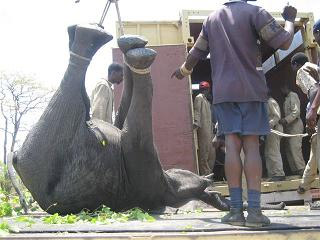 It
has not been the tradition in Africa to domesticate their wild elephants.
But greed is now starting to motivate some Tour companies to do so. In
2006, Shearwater Adventures kidnapped 12 juvenile elephants from the Hwange
National Park in Zimbabwe. It is suspected that two have already died.
It
has not been the tradition in Africa to domesticate their wild elephants.
But greed is now starting to motivate some Tour companies to do so. In
2006, Shearwater Adventures kidnapped 12 juvenile elephants from the Hwange
National Park in Zimbabwe. It is suspected that two have already died.
When I was in Thailand, I talked to Thai elephant conservationist, Lek Chailert, about what training method Africans might be using. She told me she knew exactly what they were using, namely The Crushing Box, because mahouts (Asian people who own elephants) from Thailand and Sri Lanka had been hired to teach the Africans that method. Further, she had told the Africans that they could train the elephants using love and kindness but they weren't interested in it because "it took too long".
Wildlife conservationists have tried to get in to observe what method Shearwater Adventures is using to domesticate the kidnapped juveniles, but Shearwater won't let anyone in to observe, so there is a legal battle going on presently. No one knows for sure what method they are using.
From Jennifer Hile in National Geographic Today, October 18,
2002:
It's a sound not easily forgotten. Just before dawn in the remote highlands
of northern Thailand...a four year old elephant bellows as seven village
men stab nails into her ears and feet. She is tied up and immobilized
in a small, wooden cage...The cage is called a "training crush". It's
the centerpiece of a centuries old ritual in Thailand designed to domesticate
young elephants. In addition to beatings, handlers use sleep-deprivation,
hunger and thirst to "break" the elephant's spirit and make them submissive
to their owners.
But to see The Crushing Box method as used in Thailand, view the video
below (If video does not start, click here to view):
The Zimbabwe Conservation Task Force, founded by Johnny Rodrigues, said this about the new trend in certain parts of Africa to kidnap and domesticate their wild elephants:
"According to a statement written by scientists from the Ambelosi Elephant Research Project in Kenya, the breaking up of elephant families by removing their young creates a very high level of stress, not only for the captured elephants, but also for the family members left behind. The researchers have witnessed elephant captures where the screams of the captured elephants cause their family members to attempt to rescue them. Both the elephants caught and those left behind were found to suffer physical trauma, dehydration, immune system suppression and long term psycological trauma. They claim that due to the excellent memories of elephants, they are likely to respond aggressively towards humans, vehicles and helicopters in the future.
The following paragraph was taken from their statement:
"Elephants are renowned for their memories, intelligence and sociability. Similar to those of humans, these traits also make them particularly vulnerable to stress and trauma and their long term consequences. These effects would be long lasting both for the animals removed from their families and for those remaining in the reserve. Our strong recommendation is that the authorities order, with all urgency, an immediate moratorium on the capture and training of young elephants, and prohibit all removals of this nature in future".
The attempted domestication of wild elephants is not only unspeakably cruel, but it is also very dangerous to unsuspecting tourists. An elephant that has been trained, will most likely have been subjected to cruelty and abuse. In order to make the elephant obedient, the usual method is to break its spirit. This breeds resentment and in time, some elephants have been known to turn on humans. In Zimbabwe, if an elephant kills a human, it gets the death penalty".
HOPE FOR THE FUTURE
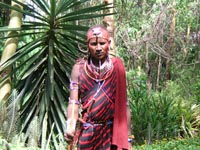 Hope for the future
of elephants is found in the nomadic, pastoral, indigenous tribes who
live side by side with elephants like the Maasai and Samburu of Kenya.
Their perspective, which is deeply engrained in their culture, sees eles
as their ancestors and as human. They say eles are human because, as they
told me, "Being human is not a matter of form but characteristics and
elephants have the same characteristics as humans." They love each other,
tenderly care for their young, celebrate birth and reunion, love to play,
mourn their dead, and have the moral ability to know right from wrong.
Hope for the future
of elephants is found in the nomadic, pastoral, indigenous tribes who
live side by side with elephants like the Maasai and Samburu of Kenya.
Their perspective, which is deeply engrained in their culture, sees eles
as their ancestors and as human. They say eles are human because, as they
told me, "Being human is not a matter of form but characteristics and
elephants have the same characteristics as humans." They love each other,
tenderly care for their young, celebrate birth and reunion, love to play,
mourn their dead, and have the moral ability to know right from wrong.
Further they told me that if they come upon a dead elephant, they stop,
honor and pay tribute to them. They cover them with leaves and ask for
permission to move on. Anyone who eats an elephant is shunned as a cannibal.
The wisdom of these ancient peoples is what we must learn, respect and
spread if the eles of Africa are to survive. We must know, in our hearts,
in our culture and in our laws, that elephants are sentient beings, so
very much like ourselves, deserving of the right to live wild and free.
A few stories of these magnificent, highly intelligent and evolved beings...
Elephants are compassionate:
Katy Payne tells this story: there was this bull ele walking along the
road and a tortoise was crossing the road. The bull was about to step
on it, noticed it was there and instead put its foot down to the side
so that the tortoise could continue on its way unharmed.
Many have heard the story of the elephants in Sri Lanka who broke through
their ropes and ran to safety, bellowing a warning that the tsunami was
coming. Then returned to pick up, one by one, people who were victims,
and moved them to safety.
Elephants have a sense of humor:
Audry Delsink tells the story of Charles, a proud bull who was trying to push over a large tree but couldn't. Several conservationists, watching him in their land rover, started laughing. He looked up, saw them laughing at him, walked over and pushed a smaller tree right down on top of their land rover! Then he sauntered off with a toss of his head and a self-satisfied swagger!
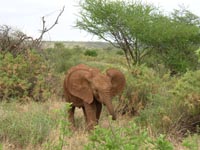 Elephants love their
family members:
Elephants love their
family members:
A family of elephants were crossing a river but a little calf was too scared to cross. So the family, already on the other side, turned around and swam back. Then together, they all walked to a part of the river that was more shallow where the baby ele could cross with them.
Elephants are highly evolved and sentient:
In his tremendous book, Elephantoms, Lyall Watson tells the story of the great madam elephant, Delilah, who was put in a small enclosure at a zoo while a larger space was built. There was a corner in the enclosure that she refused to go near, seeming to express fear. Lyall was curious why this was so and asked the zoo keeper for information. It turns out, that twenty years before, another elephant was killed in the very corner that Delilah avoided and reacted to with fright!
Elephants feel emotions:
Lyall Watson relates the story by zoologist Ivan Sanderson about a young circus elephant named Sadie. She just could not seem to learn the circus routine. In her frustration she ran out of the practice tent. The trainers brought her back and scolded her. She tried again and again but couldn't get it. Finally, Lyall relates from Sanderson, "she gave up, sank to her knees, and then laid down on her side, weeping. She lay there, said one of the horrified trainers, "tears streaming down her face, sobs racking her huge body, like a child".
Elephants communicate with other species:
Again, Lyall Watson tells this incredible story: I great lonely matriarch
was standing at the head of a cliff, rumbling and waving her trunk. He
wondered what she was doing as there were no other eles around. He investigated
and discovered that she was communicating with a whale in the bay below
the cliff!!
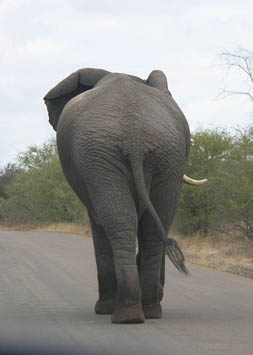
THE END

Kristal Parks, M.A.
[email protected]
303-571-0801